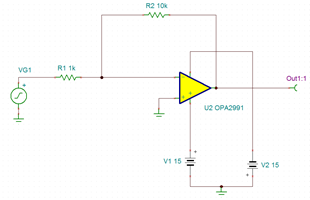Other Parts Discussed in Thread: LM7301, TINA-TI, TLV172, OPA172, OPA2991, OPA2990, OPA990, THS4561, THS4551, THP210, TLV2172
I have been using the LM7301IM5 op-amp and switched over to the OPA991 as your web site suggested as a better part. In the same circuit, the 7301 meets its slew rate spec of 1.25V/us and works well. I ordered Qty 100 of the OPA991 on order number XXXX and each one I have tried is giving me a slew rate of 0.45V/us not the 21V/us shown in the spec. and the output is very distorted. The circuit is a basic inverting amp with an input resistor of 1K ohm and a feedback resistor of 10K ohm giving a gain of -10V/V. The supply is +/- 15V and the non-inverting input is grounded. With a sine wave input of 0.5V volts for an output of 5V at 50KHz the output is very distorted and trapezoid looking. To show that the board parasitic were not to blame, I dead bugged all the parts on top of the OPA991 completely removing the board layout. The board only supplied power at this point. The output of the OPA991 was still distorted. Again, the LM7301 works fine in the same circuit. I have now tried 10 of the 100 parts I ordered and they all act the same. Could have I been sent the wrong part? The parts are marked O91V which looks correct? I need help! any idea what could be going on? This is supposed to be a better part, could I be doing something wrong? It is a very basic circuit. Thanks for your help with this!
This is the simple circuit below.
、
This image below shows the slew rate of the OPA991, the input is a 0.2 volt square wave. Same circuit as above. The image is the output. It shows a 0.533 V/us slew rate, not 21V/us as the spec shows. I have multiple parts that are doing this. Hope this helps?

Here is another screen capture of the scope image for the OPA991. Yellow is input, Blue is output. You can see the output distortion and it does not have the proper output gain. Input is a sine wave at 50KHz @ 0.5Volts peak (Yellow), output (Blue) is something less than 5V. At a gain of 10 it should be ~5Volts peak. Thanks
















